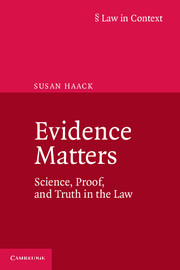Book contents
- Frontmatter
- Epigraph
- Contents
- Acknowledgments
- Introduction: A Pragmatist Perspective on Science, Proof, and Truth in the Law
- 1 Epistemology and the Law of Evidence
- 2 Epistemology Legalized
- 3 Legal Probabilism
- 4 Irreconcilable Differences? The Troubled Marriage of Science and Law
- 5 Trial and Error
- 6 Federal Philosophy of Science
- 7 Peer Review and Publication
- 8 What’s Wrong with Litigation-Driven Science?
- 9 Proving Causation
- 10 Correlation and Causation
- 11 Risky Business
- 12 Nothing Fancy
- Cases Cited
- Statutes, etc., Cited
- Bibliography
- Glossary
- Index
10 - Correlation and Causation
The “Bradford Hill Criteria” in Epidemiological, Legal, and Epistemological Perspective
Published online by Cambridge University Press: 05 August 2014
- Frontmatter
- Epigraph
- Contents
- Acknowledgments
- Introduction: A Pragmatist Perspective on Science, Proof, and Truth in the Law
- 1 Epistemology and the Law of Evidence
- 2 Epistemology Legalized
- 3 Legal Probabilism
- 4 Irreconcilable Differences? The Troubled Marriage of Science and Law
- 5 Trial and Error
- 6 Federal Philosophy of Science
- 7 Peer Review and Publication
- 8 What’s Wrong with Litigation-Driven Science?
- 9 Proving Causation
- 10 Correlation and Causation
- 11 Risky Business
- 12 Nothing Fancy
- Cases Cited
- Statutes, etc., Cited
- Bibliography
- Glossary
- Index
Summary
“So the litigation is used to shock the market?”
“Yes, and, of course, to compensate the victims. I don’t want tumors in my bladder, benign or malignant. Most jurors would feel the same way. Here’s the scenario: You put together a group of fifty or so plaintiffs, and file a big lawsuit on behalf of all Dyloft patients. At precisely the same time you launch a series of television ads soliciting more cases. You hit fast and hard, and you’ll get thousands of cases. The ads run coast to coast–quickie ads that’ll scare folks and make them dial your toll-free number right here in D.C., where you have a warehouse full of paralegals answering the phones and doing the grunt work. It’s gonna cost you some money, but if you get, say, five thousand cases, and you settle them for twenty thousand bucks each, that’s one hundred million dollars. Your cut is one third.”
“That’s outrageous!”
“No, … that’s mass tort litigation at its finest….”
–John GrishamTHE BETTER PART OF VALOR
Of course, this cynical conversation (from John Grisham’s novel The King of Torts) is fiction, not fact; still, it comes close enough to reality to bring an old proverb to mind. “Discretion is the better part of valor,” I reminded myself when, shortly after cheerfully accepting an invitation to speak at a workshop on “proof of causation in mass torts,” I realized I’d bitten off more than I could chew. For the fact is that mass torts–where large numbers of plaintiffs allege the same or closely similar injuries caused by the same defendant or group of defendants–raise far too many issues, legal, historical, and philosophical, for me to handle in one short paper (or even, I suspect, in one short lifetime!).
- Type
- Chapter
- Information
- Evidence MattersScience, Proof, and Truth in the Law, pp. 239 - 263Publisher: Cambridge University PressPrint publication year: 2014
- 2
- Cited by



